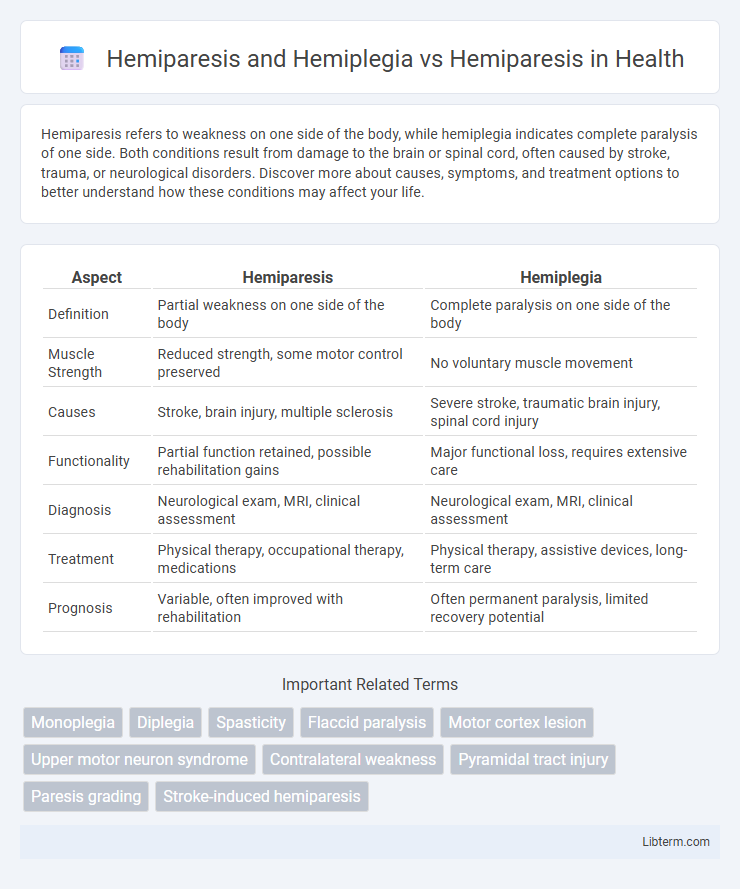Hemiparesis refers to weakness on one side of the body, while hemiplegia indicates complete paralysis of one side. Both conditions result from damage to the brain or spinal cord, often caused by stroke, trauma, or neurological disorders. Discover more about causes, symptoms, and treatment options to better understand how these conditions may affect your life.
Table of Comparison
| Aspect | Hemiparesis | Hemiplegia |
|---|---|---|
| Definition | Partial weakness on one side of the body | Complete paralysis on one side of the body |
| Muscle Strength | Reduced strength, some motor control preserved | No voluntary muscle movement |
| Causes | Stroke, brain injury, multiple sclerosis | Severe stroke, traumatic brain injury, spinal cord injury |
| Functionality | Partial function retained, possible rehabilitation gains | Major functional loss, requires extensive care |
| Diagnosis | Neurological exam, MRI, clinical assessment | Neurological exam, MRI, clinical assessment |
| Treatment | Physical therapy, occupational therapy, medications | Physical therapy, assistive devices, long-term care |
| Prognosis | Variable, often improved with rehabilitation | Often permanent paralysis, limited recovery potential |
Understanding Hemiparesis and Hemiplegia
Hemiparesis refers to partial weakness or reduced movement on one side of the body, whereas hemiplegia involves complete paralysis on one side due to neurological damage. Both conditions commonly result from stroke, traumatic brain injury, or cerebral palsy, affecting motor function and coordination. Understanding the severity and extent of neural impairment is crucial for diagnosing and implementing appropriate rehabilitation strategies to improve patient outcomes.
Key Differences Between Hemiparesis and Hemiplegia
Hemiparesis involves partial weakness or reduced motor function on one side of the body, whereas hemiplegia refers to complete paralysis of one side. The severity of muscle impairment differentiates these conditions, with hemiplegia representing a more severe loss of voluntary movement compared to hemiparesis. Clinical assessments often measure motor strength and functional abilities to distinguish between hemiparesis and hemiplegia for accurate diagnosis and treatment planning.
Causes of Hemiparesis
Hemiparesis is characterized by weakness on one side of the body, often resulting from neurological conditions such as stroke, traumatic brain injury, or multiple sclerosis. Hemiplegia involves complete paralysis of one side, typically caused by more severe brain damage or spinal cord injury. Causes of hemiparesis primarily include ischemic or hemorrhagic stroke, brain tumors, infections like encephalitis, and post-surgical complications affecting motor pathways.
Causes of Hemiplegia
Hemiplegia typically results from severe brain injuries such as stroke, traumatic brain injury, or brain tumors that cause significant damage to the motor cortex or corticospinal tract. Unlike hemiparesis, which involves partial weakness, hemiplegia is characterized by complete paralysis on one side of the body due to more extensive neuronal damage or infarction in areas like the middle cerebral artery territory. Understanding the vascular, traumatic, or neurodegenerative origins is crucial for diagnosing and managing hemiplegic conditions effectively.
Shared Symptoms and Distinguishing Features
Hemiparesis and hemiplegia both involve weakness or paralysis affecting one side of the body, commonly resulting from stroke or brain injury, with symptoms including muscle weakness, reduced coordination, and impaired motor control. Shared symptoms between hemiparesis and hemiplegia include unilateral muscle weakness, decreased voluntary movement, and possible sensory deficits, while distinguishing features reveal hemiparesis as partial weakness allowing some movement, whereas hemiplegia manifests as complete paralysis on the affected side. Accurate differentiation is critical for tailoring rehabilitation strategies, as hemiparesis often permits gradual strength recovery, while hemiplegia may require more intensive interventions to regain function.
Diagnosis: Hemiparesis vs Hemiplegia
Hemiparesis and hemiplegia are neurological conditions characterized by weakness or paralysis on one side of the body, with hemiparesis indicating partial weakness and hemiplegia representing complete paralysis. Diagnosis involves clinical examination observing muscle strength, tone, and reflexes, supplemented by neuroimaging techniques such as MRI or CT scans to identify underlying causes like stroke, brain injury, or tumors. Electromyography (EMG) and nerve conduction studies may also assist in differentiating the extent of motor impairment and guiding treatment strategies.
Treatment Approaches for Hemiparesis
Treatment approaches for hemiparesis focus on physical therapy, occupational therapy, and medications to improve motor function and muscle strength. Rehabilitation techniques such as constraint-induced movement therapy (CIMT) and neuromuscular electrical stimulation (NMES) target neuroplasticity to enhance recovery. Early intervention combined with multidisciplinary care significantly improves outcomes for patients with hemiparesis.
Treatment Strategies for Hemiplegia
Treatment strategies for hemiplegia primarily include intensive physical therapy, occupational therapy, and speech therapy to improve motor function and daily living skills. Advanced interventions such as constraint-induced movement therapy (CIMT), functional electrical stimulation (FES), and robotic-assisted rehabilitation can significantly enhance recovery outcomes. Pharmacological treatments, including muscle relaxants and antispasticity agents like baclofen, support therapy by managing symptoms such as spasticity and muscle stiffness.
Rehabilitation and Recovery Outcomes
Hemiparesis and hemiplegia both involve weakness or paralysis on one side of the body, with hemiplegia indicating more severe motor impairment. Rehabilitation outcomes vary significantly between the two, with hemiparesis patients generally demonstrating faster recovery and better functional gains due to partial muscle strength retention. Intensive physical therapy, occupational therapy, and neurorehabilitation techniques improve motor function and independence, though recovery is often slower and less complete in hemiplegia cases.
Prognosis: Comparing Long-Term Perspectives
Hemiparesis, characterized by partial weakness on one side of the body, generally presents a more favorable prognosis than hemiplegia, which involves complete paralysis on one side. Long-term outcomes for hemiparesis often include significant functional recovery through physical therapy due to the presence of some preserved motor function, whereas hemiplegia typically results in more persistent disability and slower progress. Recovery potential varies with the severity of neural damage, early intervention, and individualized rehabilitation intensity, emphasizing the importance of tailored treatment approaches.
Hemiparesis and Hemiplegia Infographic

 libterm.com
libterm.com